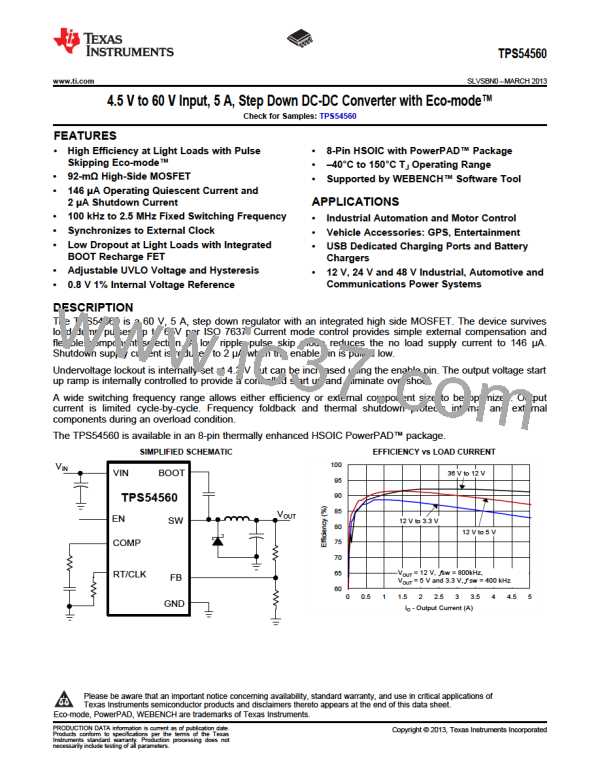TPS54560
www.ti.com
SLVSBN0 –MARCH 2013
f
=
f
f
=
1821 Hz x 1100 kHz = 44.6 kHz
co1
p(mod) x z(mod)
(43)
(44)
f
400 kHz
SW
f
=
f
=
1821 Hz x
= 19.1 kHz
co2
p(mod) x
2
2
To determine the compensation resistor, R4, use Equation 45. Assume the power stage transconductance,
gmps, is 17 A/V. The output voltage, VO, reference voltage, VREF, and amplifier transconductance, gmea, are 5
V, 0.8 V and 350 μA/V, respectively. R4 is calculated to be 16.8 kΩ and a standard value of 16.9 kΩ is selected.
Use Equation 46 to set the compensation zero to the modulator pole frequency. Equation 46 yields 5172 pF for
compensating capacitor C5. 4700 pF is used for this design.
æ
ç
è
ö
÷
ø
æ 2´ p´ f ´ C
ö
÷
ø
V
OUT
æ
ç
è
ö
÷
ø
2´ p´ 29.2 kHz ´ 87.4 mF
17 A / V
5V
æ
ö
co
OUT
R4 =
x
=
x
= 16.8 kW
ç
ç
÷
gmps
V
x gmea
0.8 V x 350 mA / V
è
ø
è
REF
(45)
1
1
C5 =
=
= 5172 pF
2´ p´R4 x f
2´ p´16.9 kW x 1821 Hz
p(mod)
(46)
A compensation pole can be implemented if desired by adding capacitor C8 in parallel with the series
combination of R4 and C5. Use the larger value calculated from Equation 47 and Equation 48 for C8 to set the
compensation pole. The selected value of C8 is 47 pF for this design example.
C
x R
ESR
87.4 mF x 1.67 mW
OUT
C8 =
=
= 8.64 pF
R4
16.9 kW
(47)
(48)
1
1
C8 =
=
= 47.1 pF
R4 x f sw x p
16.9 kW x 400 kHz x p
Discontinuous Conduction Mode and Eco-mode Boundary
With an input voltage of 12 V, the power supply enters discontinuous conduction mode when the output current
is less than 408 mA. The power supply enters Eco-mode when the output current is lower than 25.3 mA. The
input current draw is 257 μA with no load.
Copyright © 2013, Texas Instruments Incorporated
Submit Documentation Feedback
27
Product Folder Links: TPS54560

 TI [ TEXAS INSTRUMENTS ]
TI [ TEXAS INSTRUMENTS ]